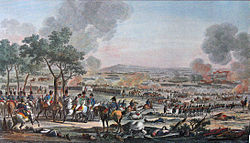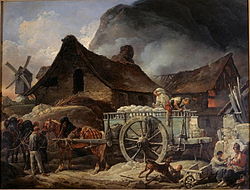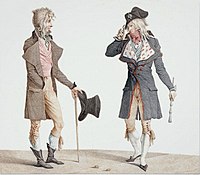Carle Vernet
This article has multiple issues. Please help improve it or discuss these issues on the talk page. (Learn how and when to remove these messages)
|
Carle Vernet | |
|---|---|
 Vernet by Robert Lefèvre, 1804 | |
| Born | Antoine Charles Horace Vernet 14 August 1758 |
| Died | 27 November 1836 (aged 78) |
| Nationality | French |
| Occupation | Painting |
| Children | Horace Vernet |
| Parent | Claude Joseph Vernet |
Antoine Charles Horace Vernet, better known as Carle Vernet (French pronunciation: [kaʁl vɛʁnɛ]; 14 August 1758 – 27 November 1836), was a French painter, the youngest child of Claude-Joseph Vernet and the father of Horace Vernet.
Biography
[edit]
Vernet was born in Bordeaux. At the age of five, he showed an extraordinary passion for drawing horses, but went through the regular academic course as a pupil of his father and of Nicolas-Bernard Lépicié. Strangely, after winning the Prix de Rome (1782), he seemed to lose interest in the occupation, and his father had to recall him from Rome to prevent his entering a monastery.[1]
In his "Triumph of Aemilius Paulus", Vernet broke with tradition and drew the horse with the forms he had learnt from nature in stables and riding schools.[1] His hunting pieces, races, landscapes, and work as a lithographer were also very popular.
Carle's sister was executed by the guillotine during the Revolution. After this, he gave up art.

When he again began to produce under the French Directory (1795–1799), his style had changed radically. He started drawing in minute detail battles and campaigns to glorify Napoleon.[citation needed] His drawings of Napoleon's Italian campaign won acclaim as did the Battle of Marengo, and for his Morning of Austerlitz Napoleon awarded him the Legion of Honour,[1] and Louis XVIII of France awarded him the Order of Saint Michael. Afterwards he excelled in hunting scenes and depictions of horses.
He produced a painting Capture of Pamplona celebrating the 1823 Siege of Pamplona which he exhibited at the Paris Salon of 1824.
In addition to being a painter and lithographer, Carle Vernet was an avid horseman. Just days before his death at the age of seventy-eight, he was seen racing as if he were a sprightly young man.
Literary references
[edit]In Arthur Conan Doyle's short story "The Adventure of the Greek Interpreter", fictional detective Sherlock Holmes claims that his grandmother is the French artist, Vernet's sister, without stating whether this is Claude Joseph Vernet, Carle Vernet, or Horace Vernet.
In Maria Wirtemberska's novel Malvina, or the Heart's Intuition (1816; English translation 2001, by Ursula Phillips), it is said that a view that is being described merits the talent of Vernet, who as the writer explains in her own footnote was a sea painter.
Selected works
[edit]-
Arrival of Emigres on the French Coast with the Duchess of Berry
-
A Mameluke Leading His Horse
-
Napoleon at the Battle of Borodino
-
Un Incroyable, two French dandies, one bearing what may be the first recorded top hat
-
Capture of Pamplona, 1824
See also
[edit]References
[edit]- ^ a b c d One or more of the preceding sentences incorporates text from a publication now in the public domain: Chisholm, Hugh, ed. (1911). "Vernet s.v. Antoine Charles Horace Vernet". Encyclopædia Britannica. Vol. 27 (11th ed.). Cambridge University Press. p. 1030.





